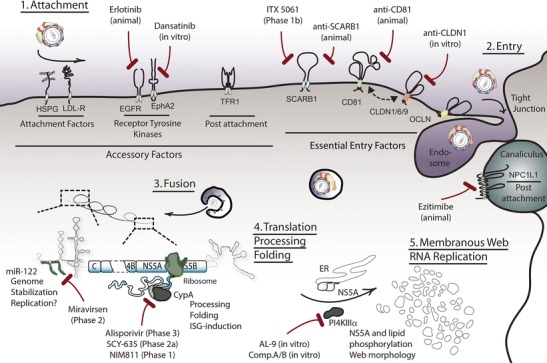Fig. 1.

HCV life cycle and critical host factors for intervention. HCV requires host proteins and RNAs during its life cycle offering several points of intervention using HTAs. Initially, HCV-lipoviroparticles attach to LDL-R and heparan sulfate proteoglycans (HSPG) on the surface of hepatocytes, followed by a coordinated uptake requiring the essential entry factors SCARB1, CD81, CLDNs and OCLN. The latter four entry factors can be targeted by specific antibodies or small molecules, like ITX 5061, which blocks HCV-SCARB1 interactions and is in clinical phase 1b development. Accessory factors including receptor tyrosine kinases, transferrin receptor 1 (TFR1) and the cholesterol receptor NPC1L1 provide alternative targets for entry blockage. After internalization and particle uncoating, the HCV RNA genome replicates in specialized cytosolic compartments, termed membraneous webs. Formation of these replication complexes is aided by host and viral proteins. Inhibition of the host chaperone CypA by cyclosporine and its derivatives (alisporivir, SCY-635, NIM811) affects function of the viral NS5A protein and thereby inhibits HCV replication. Alisporivir, SCY-635, NIM811 are currently tested in clinical phases 3, 2 and 1, respectively. PI4KIIIα is a host lipid kinase required for membraneous web formation and its inhibition by small molecules, like AL-9, abolishes HCV replication. A third class of replication HTAs is comprised by antagomirs of the host miR-122. This microRNA binds to and stabilizes the HCV RNA genome and facilitates its translation. Moreover, an involvement of miR-122 in HCV RNA replication is being discussed. Sequestration of miR-122 by miravirsen, a clinical phase 2 HTA, strongly suppresses viral titers
